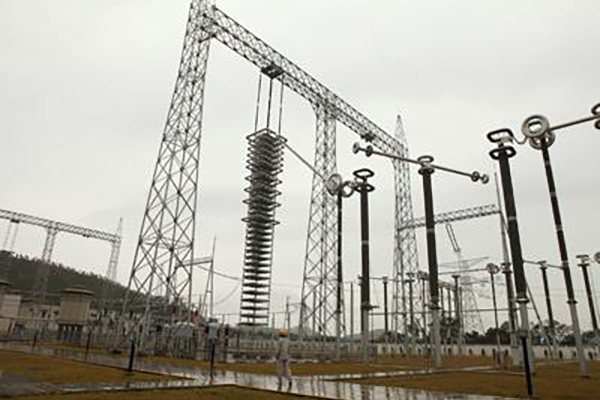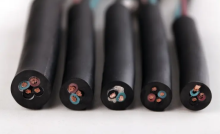Por que usar o cabo HVDC para transmissão de longa distância?


The difference between HVDC overhead line and HVAC overhead line.
Em um moderno sistema de transmissão DC, apenas o link de transmissão é DC, o sistema de geração e o sistema de consumo ainda são AC. Na extremidade emissora da linha de transmissão, a energia CA do sistema CA é enviada ao retificador através do transformador conversor na estação conversora. O que transforma a energia CA de alta tensão em energia CC de alta tensão e a envia para a linha de transmissão CC.
A energia CC é enviada ao inversor na estação conversora na extremidade receptora através da linha de transmissão, que transforma a energia CC de alta tensão em um linha de energia CA de alta tensão. E então transmite a energia para o sistema AC através do transformador conversor. No sistema de transmissão DC, o inversor pode funcionar no estado retificado ou invertido controlando o conversor.


A transmissão HVDC tem muitas vantagens em comparação com a transmissão AC
1. A linha de transmissão HVDC é significativamente mais econômica. Ao transmitir a mesma potência, o fio usado em linhas de transmissão DC é apenas 1/2 para 2/3 daquele usado na transmissão AC. A linha de transmissão DC usa um sistema de dois fios e é comparada com um sistema de três fios, transmissão CA trifásica, sob as mesmas condições de seção transversal do fio da linha de transmissão e densidade de corrente. Se o efeito de pele não for considerado, a linha de transmissão e os materiais de isolamento podem ser economizados em cerca de 1/3 da mesma energia elétrica.
Se o efeito de pele e várias perdas forem levados em consideração, a área da seção transversal do fio usado para transmitir a mesma potência CA é maior ou igual a 1.33 vezes a área da seção transversal do fio usado para transmissão DC. Portanto, o fio usado para transmissão DC é quase metade daquele usado para transmissão AC.
Em linhas de transmissão por cabo, linhas de transmissão DC de alta tensão não geram correntes capacitivas, enquanto as linhas de transmissão AC têm correntes capacitivas, que causam perdas. Em algumas ocasiões especiais, como quando a linha de transmissão passa pelo estreito, Cabos DC devem ser usados.
Devido ao capacitor coaxial formado entre o núcleo do cabo e a terra, a corrente capacitiva sem carga é extremamente considerável na linha de transmissão de alta tensão CA. Na linha de transmissão DC, não há corrente capacitiva adicionada ao cabo porque a flutuação de tensão é muito pequena.
3. Quando a transmissão DC é usada, o sistema AC em ambas as extremidades da linha não precisa funcionar de forma síncrona, enquanto a transmissão AC deve funcionar de forma síncrona. Quando a transmissão CA de longa distância é usada, há uma diferença significativa na fase das correntes em ambas as extremidades do sistema de transmissão CA.
Esses dois fatores fazem com que o sistema AC fique dessincronizado e precise ser ajustado com um sistema de compensação complexo e grande e uma tecnologia muito abrangente. De outra forma, uma forte corrente de loop pode ser formada no equipamento e danificar o equipamento, ou causar uma interrupção devido à operação não sincronizada.
Quando linhas de transmissão CC são usadas para interconectar dois sistemas CA, a rede CA em ambas as extremidades pode operar em sua frequência e fase sem ajuste síncrono.
4. O sistema de transmissão de energia HVDC é fácil de controlar e rápido, e a perda em caso de falha é menor que a da transmissão AC. Se dois sistemas CA estiverem interconectados por linhas CA, quando um curto-circuito ocorre em um lado do sistema, o outro lado deve fornecer corrente de curto-circuito para o lado da falta.
Portanto, a capacidade dos disjuntores originais em ambos os lados do sistema de cortar a corrente de curto-circuito será ameaçada e os disjuntores precisarão ser substituídos. Se os dois sistemas AC estiverem interligados por uma linha de transmissão DC. A potência do circuito pode ser ajustada de forma rápida e fácil devido ao uso de dispositivos controlados por silício, a corrente de curto-circuito fornecida pela linha de transmissão CC ao sistema CA em curto-circuito não é grande. E a corrente de curto-circuito do sistema CA do lado da falha é quase a mesma de quando não há interconexão. Portanto, não é necessário substituir o interruptor original e o equipamento de transporte de corrente em ambos os lados.
5. No projeto de transmissão HVDC, cada pólo é regulado de forma independente e funciona sem influência um do outro.
Portanto, quando um pólo falha, apenas o pólo defeituoso precisa ser desligado e o outro pólo ainda pode fornecer pelo menos 50% do poder. No entanto, em uma linha de transmissão AC, uma falta permanente em qualquer fase deve resultar em uma interrupção completa da linha.
Recent Posts
Como entender rapidamente qual é o cabo trifásico? Favorito aqui!
In the world of industrial and commercial power distribution, three-phase cables play a critical role…
Tempestades e inundações! Como os cabos impermeáveis protegem a energia?
Introduction In recent years, heavy rainfall and flooding have become increasingly frequent worldwide, causing severe…
O papel e os desafios da indústria de cabos na economia circular
Introduction As sustainability becomes a global priority, industries across the spectrum are reevaluating their operations…
Como a indústria de cabos pode enfrentar o desafio da cadeia de suprimentos global?
The global supply chain is an intricate and essential network that connects manufacturers, distributors, retailers,…
O impacto das energias renováveis na demanda por cabos
Introduction The global shift toward renewable energy has become a cornerstone of efforts to combat…
Previsão de tendência global do mercado de cabos 2025
The global cable market is integral to a wide array of industries, including energy, telecommunications,…


